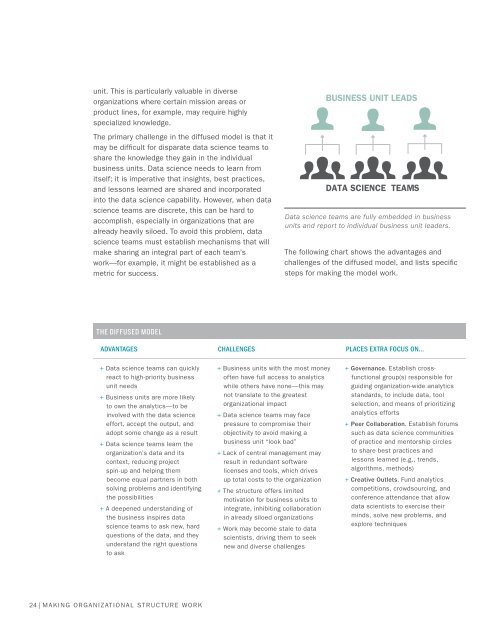Tips for Building a Data Science Capability
WH4vS
WH4vS
You also want an ePaper? Increase the reach of your titles
YUMPU automatically turns print PDFs into web optimized ePapers that Google loves.
unit. This is particularly valuable in diverse<br />
organizations where certain mission areas or<br />
product lines, <strong>for</strong> example, may require highly<br />
specialized knowledge.<br />
The primary challenge in the diffused model is that it<br />
may be difficult <strong>for</strong> disparate data science teams to<br />
share the knowledge they gain in the individual<br />
business units. <strong>Data</strong> science needs to learn from<br />
itself; it is imperative that insights, best practices,<br />
and lessons learned are shared and incorporated<br />
into the data science capability. However, when data<br />
science teams are discrete, this can be hard to<br />
accomplish, especially in organizations that are<br />
already heavily siloed. To avoid this problem, data<br />
science teams must establish mechanisms that will<br />
make sharing an integral part of each team’s<br />
work—<strong>for</strong> example, it might be established as a<br />
metric <strong>for</strong> success.<br />
BUSINESS UNIT LEADS<br />
DATA SCIENCE TEAMS<br />
<strong>Data</strong> science teams are fully embedded in business<br />
units and report to individual business unit leaders.<br />
The following chart shows the advantages and<br />
challenges of the diffused model, and lists specific<br />
steps <strong>for</strong> making the model work.<br />
THE DIFFUSED MODEL<br />
ADVANTAGES CHALLENGES PLACES EXTRA FOCUS ON…<br />
+ <strong>Data</strong> science teams can quickly<br />
react to high-priority business<br />
unit needs<br />
+ Business units are more likely<br />
to own the analytics—to be<br />
involved with the data science<br />
ef<strong>for</strong>t, accept the output, and<br />
adopt some change as a result<br />
+ <strong>Data</strong> science teams learn the<br />
organization’s data and its<br />
context, reducing project<br />
spin-up and helping them<br />
become equal partners in both<br />
solving problems and identifying<br />
the possibilities<br />
+ A deepened understanding of<br />
the business inspires data<br />
science teams to ask new, hard<br />
questions of the data, and they<br />
understand the right questions<br />
to ask<br />
+ Business units with the most money<br />
often have full access to analytics<br />
while others have none—this may<br />
not translate to the greatest<br />
organizational impact<br />
+ <strong>Data</strong> science teams may face<br />
pressure to compromise their<br />
objectivity to avoid making a<br />
business unit “look bad”<br />
+ Lack of central management may<br />
result in redundant software<br />
licenses and tools, which drives<br />
up total costs to the organization<br />
+ The structure offers limited<br />
motivation <strong>for</strong> business units to<br />
integrate, inhibiting collaboration<br />
in already siloed organizations<br />
+ Work may become stale to data<br />
scientists, driving them to seek<br />
new and diverse challenges<br />
+ Governance. Establish crossfunctional<br />
group(s) responsible <strong>for</strong><br />
guiding organization-wide analytics<br />
standards, to include data, tool<br />
selection, and means of prioritizing<br />
analytics ef<strong>for</strong>ts<br />
+ Peer Collaboration. Establish <strong>for</strong>ums<br />
such as data science communities<br />
of practice and mentorship circles<br />
to share best practices and<br />
lessons learned (e.g., trends,<br />
algorithms, methods)<br />
+ Creative Outlets. Fund analytics<br />
competitions, crowdsourcing, and<br />
conference attendance that allow<br />
data scientists to exercise their<br />
minds, solve new problems, and<br />
explore techniques<br />
24 | MAKING ORGANIZATIONAL STRUCTURE WORK


